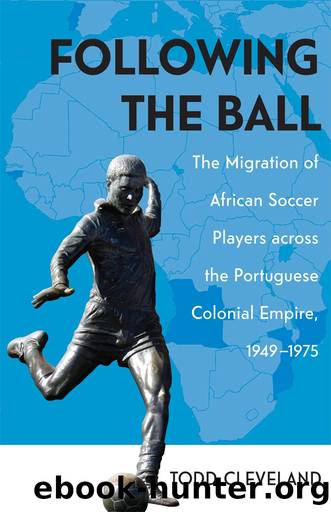Following the Ball: The Migration of African Soccer Players Across the Portuguese Colonial Empire, 1949-1975 by Todd Cleveland

Author:Todd Cleveland [Cleveland, Todd]
Language: eng
Format: epub
Tags: History, Africa, General, Social Science, Emigration & Immigration, Sports & Recreation, Basketball, Political Science, Colonialism & Post-Colonialism
ISBN: 9780896804999
Google: YNo5DwAAQBAJ
Goodreads: 36701873
Publisher: Ohio University Press
Published: 2017-10-16T00:00:00+00:00
Figure 4.1. Académicaâs starting eleven, prior to a March 5, 1961, match versus FC Porto, which featured four African players: Augusto Araújo (standing, far left); Mário Torres (standing, third from right); Mário Wilson (standing, second from right); and Daniel Chipenda (kneeling, second from left).
One of the first African players to benefit from this measure was Mário Wilson, who initially signed with Sporting in 1949, but who, by 1951, had transferred to Académica. According to Wilson, âSporting didnât want me leaving the club, so only after the secretary of education created the law was I able to leave Sporting to go to Coimbra. . . . With just soccer, you could live well for five or six years and then fall off the map. . . . It was a huge risk. Therefore, many players would choose Académica so that they could achieve more in their lives.â104 Indeed, even while Wilson was toiling with Sporting, he continued to study. During an interview from 2009, on the occasion of his eightieth birthday, he attributed this commitment to his fatherâs influence: âMy father, because of his education, knew that football was something that was fleeting.â105 Wilson also astutely remarked, âSporting exposed me to a school of learning about football in all of its different aspects, but Académica and Coimbra showed me an authentic âschool of life,â which went far beyond football.â106
Augusto Araújo, an Angolan who first arrived in Portugal in 1956 to play for Benfica, exhibited similar priorities. Just two seasons after his arrival, Araújo made his way to Académica, loaned out by the Lisbon club. In a 1960 interview, he explained his motivations: âBenfica is a great club. And I am its player . . . but Académica offers me more possibilities to rise socially, and by studying, a secure future. My ambition has always been to become an engineer. I came to Lisbon with this intention, ready to fight for it, and I havenât relented. I know that through this achievement I will give my parents and brother great happiness.â107
Although metropolitan clubs were legally required to release their players to Académica, the squads that were poised to lose footballers in this manner were typically resistant and occasionally succeeded in sabotaging the transfers. In one such case, Ferreira Pinto, an Angolan midfielder who played for Sporting from 1958 until 1962, requested a move to Coimbra that the Lisbon club rejected. Pinto was always interested in pursuing his studies, knowing that the life of a footballer was âephemeral and that the future was not something with which you can fool around.â108 As such, he had continued to study while in Portugal, with Sporting paying his schooling expenses. At the end of the 1958 season his first with the club, his lack of playing time prompted him to approach the clubâs directors regarding the possibility of a transfer to Coimbra. Sporting declined, however, following which the player spent three more seasons in Lisbon before the expiration of his contract finally enabled him to transfer away from the club.
Download
This site does not store any files on its server. We only index and link to content provided by other sites. Please contact the content providers to delete copyright contents if any and email us, we'll remove relevant links or contents immediately.
